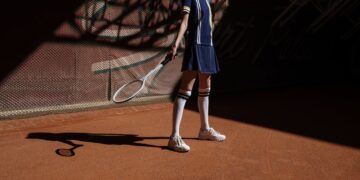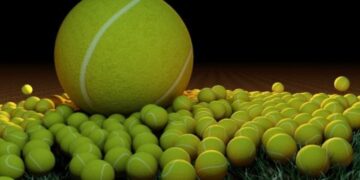Tennis is not just a sport—it’s a dynamic blend of fitness, strategy, mental fortitude, and technical skill. Whether you’re a true beginner or an aspiring club player, learning how to play tennis like a pro is about much more than hitting the ball over the net. This comprehensive guide brings you the latest techniques, strategies, and insider tips straight from professional training in 2026, designed to help you elevate your game quickly and enjoy the process.
Table of Contents
-
Introduction
-
Getting Started: The Right Mindset
-
Choosing Your Equipment and Gear
-
Mastering Technique: Grips, Stance, and Footwork
-
Developing Powerful Strokes and Serves
-
Building an Effective Game Plan
-
Conditioning, Strength & Recovery
-
Mental Preparation & Focus
-
Frequently Asked Questions
-
Conclusion & Call to Action
Introduction: Why Tennis Is the Perfect Sport for Everyone
Tennis is more popular than ever before. With over 87 million active players worldwide in 2026, it is recognized for boosting cardiovascular fitness, agility, hand-eye coordination, and social interaction. Tennis is a lifelong sport—you can start as a child or pick it up well into adulthood. But progressing from casual rallying to playing “like a pro” requires a roadmap: clear steps, the right motivation, proper equipment, and an understanding of modern training principles.
Primary Keywords: how to play tennis, tennis training, tennis tips
LSI/Related Terms: tennis strategy, tennis exercises, tennis mental game, beginner tennis tips, tennis drills
Getting Started: Adopting a Pro Mindset
Developing the Right Attitude and Goals
Success in tennis starts with your mindset. The world’s top players emphasize consistency, resilience, and positive self-talk.
Key principles for new players:
-
Set achievable goals: Focus on getting 10 forehand shots in a row, not winning every point at first.
-
Enjoy the learning process: Mistakes are part of progress!
-
Stay positive: Use phrases like “I’m here to learn” and “It’s okay to make mistakes.”
-
Visualize success: Picture yourself executing perfect strokes.
Practical Example:
Many club players improve by breaking down their goals: first by mastering court positioning, then by learning to grip the racquet properly, and finally by consistently hitting simple shots. Mindful breathing and visualization techniques are recommended to sharpen focus and ease nerves during lessons.
Choosing The Best Equipment: Racquet, Shoes, and Attire
Gear Up for Tennis Success
Your gear can make or break your early tennis experience. In 2026, technology has made racquet selection and smart clothing easier for every budget.
Must-have tennis gear:
-
Racquet:
-
Comfort and Weight: Beginners should prioritize lighter racquets (260–280g) for easier handling.
-
Grip Size: Choose a grip that fits comfortably in your hand—using the ruler test (distance from tip of ring finger to second crease in palm).
-
Head Size: Larger head sizes (100–110 sq. in.) offer more hitting area and forgiveness on off-center shots.
-
-
Shoes:
-
Opt for tennis-specific shoes with lateral support to avoid injury.
-
Cushioned soles help when moving rapidly on hard courts.
-
-
Apparel:
-
Breathable fabrics and moisture-wicking tennis attire keep you cool during intense play.
-
Expert Tip:
In 2026, many beginners are choosing racquets with built-in sensors to analyze stroke technique and track progress.
Mastering Technique: Grips, Stances, and Footwork for Beginners
Tennis Fundamentals—How Pros Train in 2026
Proper grip and footwork set the foundation for every shot.
Gripping the Racquet Correctly
-
Forehand grip: Flat racket on the ground, pick it up with your dominant hand (semi-western grip)—easy and effective for most beginners.
-
Backhand grip: Eastern grip is recommended for stability and control.
-
Serve grip: Master the continental grip for versatile serve execution.
Perfecting Stance and Footwork
-
Open stance: Used for most forehand and backhand strokes—provides stability and allows for quick lateral movement.
-
Split step: Bounce slightly on the balls of your feet before your opponent hits—prepares you to move in any direction.
-
Footwork drills:
-
Cone drill: Place cones about 3–5 feet apart along the baseline. Practice moving quickly and smoothly between them.
-
Shuttle runs: Sprint from baseline to net and back, improving reaction speed.
-
Building Consistency with Practice
-
Focus on basic strokes: forehand, backhand, and serve.
-
Start with smaller courts or shorter rallies for control.
-
Work on positioning and balance to stay centered during exchanges.
Developing Powerful Strokes and Serves
Unleashing Explosive Power—Pro Techniques (2026)
Even beginners can learn techniques used by elite players to generate power and control:
Modern Training for Power
-
Plyometrics precision: Training with box jumps, lateral bounds, and medicine ball throws increases muscle explosiveness.
-
Strength training: Use squats, deadlifts, and bench presses focused on speed and stability. Unilateral exercises boost on-the-run performance.
-
VO2 Max optimization: Pros focus on cardio—court sprints and shuttle runs help you last longer and recover faster.
Technique for Maximum Spin & Accuracy
-
Accelerate your racquet through the ball for more spin on serves and groundstrokes.
-
Incorporate drills that target shot placement and reaction time:
-
Groundstroke drill: Rally with a partner, focusing on keeping shots deep and consistent.
-
Serve and volley drill: Alternate between serving and rushing the net, practicing volleys and overhead shots.
-
Case Study:
In 2026, training regimens increasingly use data tracking—players aim for measurable improvements in serve velocity (top men: 200+ km/h, top women: 180+ km/h) and rally consistency.
Building a Winning Tennis Game Plan
Strategy, Tactics, and Match Preparation
Analyzing Your Strengths and Opponent’s Weaknesses
-
Chart your strengths: Are you best at forehand rallies, net play, or defensive work?
-
Analyze your opponent: Watch for habits—do they struggle with backhands or net play?
-
Exploit weaknesses: Aim shots to their non-dominant side or use deeper, topspin drives.
Developing a Tactical Approach
-
In singles, cover the court and use your strongest shots to control rallies.
-
In doubles, teamwork is key—communicate and anticipate partner movements.
-
Mix aggressive net play, spin variation, and patience depending on the match.
Keeping the Ball in Play
-
Consistency beats risky winners. Long rallies test your opponent’s endurance and mental resilience.
-
Practice keeping unforced errors low; the winner is often the more patient player.
Conditioning, Strength, and Injury Prevention
The Modern Tennis Fitness Regimen
Pro-Level Conditioning (2026 Updates)
-
Strength training for stability: Focus on shoulders, core, and ankle exercises. Use resistance bands for injury prevention.
-
Active recovery: Incorporate foam rolling and massage after practice.
-
Sleep optimization: The latest sports science shows sleep is critical for recovery and cognitive performance on court.
Practical Warm-Up Routine
-
5 minutes of gentle jogging or jump rope
-
Dynamic stretches: high knees, arm circles, leg swings
-
2–3 minutes of shadow swings (forehand, backhand, serve)
-
Short practice rallies with a partner
Mental Preparation and Staying Focused
The Psychology of Tennis—Winning the Mental Game
Staying Calm and Focused During Matches
-
Mindful breathing: Slow breaths relax nerves before every point.
-
Positive routines: Bounce the ball the same number of times before serving, or use a short mantra.
Dealing with Pressure and Setbacks
-
Accept mistakes and move on—don’t dwell on lost points.
-
Use transition words and phrases (“next shot,” “reset,” “focus ahead”) to maintain concentration.
FAQs—Your Top Tennis Questions Answered
Frequently Asked Questions about Learning Tennis Like a Pro
1. What’s the best age to start playing tennis?
Answer: Tennis can be learned at any age. Children as young as 4 can start, and adults of all ages successfully pick up the sport thanks to adaptable equipment and beginner classes.
2. How can I improve my tennis serve quickly?
Answer: Focus on technique—use the continental grip, start with slow, deliberate motions, and practice aiming for consistent ball toss height. Add power gradually as you gain control.
3. What physical exercises boost tennis performance?
Answer: Plyometrics, shuttle runs, squats, lunges, and core strengthening (planks, medicine ball twists) are highly recommended for tennis-specific power and endurance.playtennis+1
4. How often should a beginner practice?
Answer: At least 2–3 times per week for steady improvement, with each session lasting 45–60 minutes. Split time between drills, rallies, and match play for balanced progress.
5. Is tennis more about fitness or technique?
Answer: It’s a blend of both. Technique determines shot accuracy, while fitness supports endurance, recovery, and injury prevention.
6. Can you learn tennis without a coach?
Answer: Absolutely—many resources (online videos, community courts, apps) help you learn solo. However, a coach accelerates progress by providing instant feedback and structured plans.
7. How do I avoid common beginner injuries?
Answer: Warm up before playing, stretch regularly, use the right shoes, and don’t play through pain. Listen to your body and prioritize recovery days.
Conclusion: Take Your Tennis Journey to the Next Level
Playing tennis “like a pro” starts by mastering basics, embracing a positive mindset, using smart gear, and sticking to modern best practices. With the latest advances in tennis training, equipment, and wellness in 2026, anyone can dramatically improve skills, fitness, and enjoyment of the game.
Are you ready to step onto the court and discover your tennis potential? Grab your racquet, lace up your shoes, and put these expert tennis tips into action today. Leave a comment below sharing your biggest tennis challenge, and don’t forget to check out our related articles for more advanced drills and player testimonials!
Remember: Consistency, patience, and a love for the game are your greatest allies! Bold your goals, take short steps, and enjoy every rally. See you on the court!
- https://eu.clifbar.com/en/stories/10-tennis-tips-for-beginners/
- https://www.playtennis.sg/online-tennis-education/tips-improve-your-tennis
- https://www.lta.org.uk/play/how-to-get-started/
- https://teachme.to/blog/6-ways-to-prepare-for-your-first-tennis-lesson-cm4mz4dwh00cg10m8zgty4gpm
- https://www.tvi-mp3.com/blog/insights/conquest-marketing-in-the-automotive-industry/
- https://thejacksonclinics.com/bring-your-a-game-best-preparation-for-tennis/
- https://www.specialolympicsga.org/wp-content/uploads/2010/03/Tennis+Coaching+Guide.pdf
- https://www.youtube.com/watch?v=foD2mMKl7xs
- https://www.youtube.com/watch?v=umITsC6m98c
- https://www.bicestergym.co.uk/6-key-tennis-tips-for-beginners/











